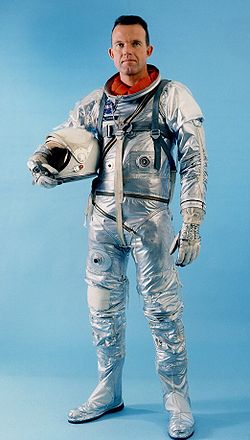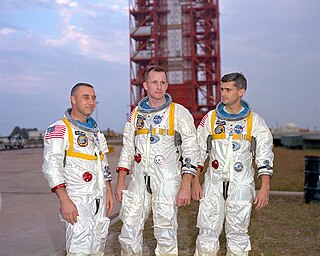
Apollo 1, initially designated AS-204, was planned to be the first crewed mission of the Apollo program, the American undertaking to land the first man on the Moon. It was planned to launch on February 21, 1967, as the first low Earth orbital test of the Apollo command and service module. The mission never flew; a cabin fire during a launch rehearsal test at Cape Kennedy Air Force Station Launch Complex 34 on January 27 killed all three crew members—Command Pilot Gus Grissom, Senior Pilot Ed White, and Pilot Roger B. Chaffee—and destroyed the command module (CM). The name Apollo 1, chosen by the crew, was made official by NASA in their honor after the fire.

Project Mercury was the first human spaceflight program of the United States, running from 1958 through 1963. An early highlight of the Space Race, its goal was to put a man into Earth orbit and return him safely, ideally before the Soviet Union. Taken over from the US Air Force by the newly created civilian space agency NASA, it conducted 20 uncrewed developmental flights, and six successful flights by astronauts. The program, which took its name from Roman mythology, cost $2.68 billion. The astronauts were collectively known as the "Mercury Seven", and each spacecraft was given a name ending with a "7" by its pilot.
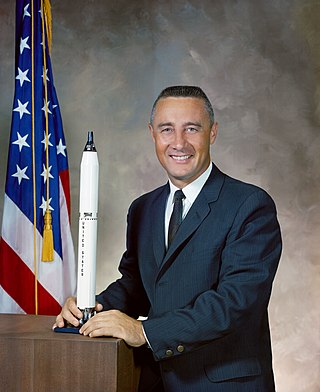
Virgil Ivan "Gus" Grissom was an American engineer and pilot in the United States Air Force, as well as one of the original men, the Mercury Seven, selected by the National Aeronautics and Space Administration for Project Mercury, a program to train and launch astronauts into outer space. Grissom was also a Project Gemini and Apollo program astronaut for NASA. As a member of the NASA Astronaut Corps, Grissom was the second American to fly in space in 1961. He was also the second American to fly in space twice, preceded only by Joe Walker with his sub-orbital X-15 flights.

A space suit is an environmental suit used for protection from the harsh environment of outer space, mainly from its vacuum as a highly specialized pressure suit, but also its temperature extremes, as well as radiation and micrometeoroids. Basic space suits are worn as a safety precaution inside spacecrafts in case of loss of cabin pressure. For extravehicular activity (EVA) more complex space suits are worn, featuring a portable life support system.

Gemini 3 was the first crewed mission in NASA's Project Gemini and was the first time two American astronauts flew together into space. On March 23, 1965, astronauts Gus Grissom and John Young flew three low Earth orbits in their spacecraft, which they nicknamed Molly Brown. It was the first U.S. mission in which the crew fired thrusters to change the size and shape of their orbit, a key test of spacecraft maneuverability vital for planned flights to the Moon. It was also the final crewed flight controlled from Cape Kennedy Air Force Station in Florida, before mission control functions were moved to a new control center at the newly opened Manned Spacecraft Center in Houston, Texas.

Mercury-Redstone 3, or Freedom 7, was the first United States human spaceflight, on May 5, 1961, piloted by astronaut Alan Shepard. It was the first crewed flight of Project Mercury. The project had the ultimate objective of putting an astronaut into orbit around the Earth and returning him safely. Shepard's mission was a 15-minute suborbital flight with the primary objective of demonstrating his ability to withstand the high g-forces of launch and atmospheric re-entry.

Mercury-Redstone 4 was the second United States human spaceflight, on July 21, 1961. The suborbital Project Mercury flight was launched with a Mercury-Redstone Launch Vehicle, MRLV-8. The spacecraft, Mercury capsule #11, was nicknamed Liberty Bell 7. It was piloted by astronaut Virgil "Gus" Grissom.

Mercury-Atlas 9 was the final crewed space mission of the U.S. Mercury program, launched on May 15, 1963, from Launch Complex 14 at Cape Canaveral, Florida. The spacecraft, named Faith 7, completed 22 Earth orbits before splashing down in the Pacific Ocean, piloted by astronaut Gordon Cooper, then a United States Air Force major. The Atlas rocket was No. 130-D, and the Mercury spacecraft was No. 20. As of January 2024, this mission marks the last time an American was launched alone to conduct an entirely solo orbital mission.
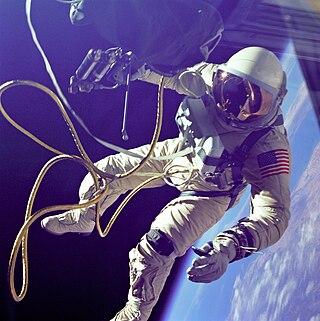
Gemini 4 was the second crewed spaceflight in NASA's Project Gemini, occurring in June 1965. It was the tenth crewed American spaceflight. Astronauts James McDivitt and Ed White circled the Earth 66 times in four days, making it the first US flight to approach the five-day flight of the Soviet Vostok 5. The highlight of the mission was the first space walk by an American, during which White floated free outside the spacecraft, tethered to it, for approximately 23 minutes.

Project Gemini was the second United States human spaceflight program to fly. Conducted after the first American crewed space program, Project Mercury, while the Apollo program was still in early development, Gemini was conceived in 1961 and concluded in 1966. The Gemini spacecraft carried a two-astronaut crew. Ten Gemini crews and 16 individual astronauts flew low Earth orbit (LEO) missions during 1965 and 1966.

A space capsule is a spacecraft designed to transport cargo, scientific experiments, and/or astronauts to and from space. Capsules are distinguished from other spacecraft by the ability to survive reentry and return a payload to the Earth's surface from orbit or sub-orbit, and are distinguished from other types of recoverable spacecraft by their blunt shape, not having wings and often containing little fuel other than what is necessary for a safe return. Capsule-based crewed spacecraft such as Soyuz or Orion are often supported by a service or adapter module, and sometimes augmented with an extra module for extended space operations. Capsules make up the majority of crewed spacecraft designs, although one crewed spaceplane, the Space Shuttle, has flown in orbit.

A pressure suit is a protective suit worn by high-altitude pilots who may fly at altitudes where the air pressure is too low for an unprotected person to survive, even when breathing pure oxygen at positive pressure. Such suits may be either full-pressure or partial-pressure. Partial-pressure suits work by providing mechanical counter-pressure to assist breathing at altitude.

ILC Dover, LP is a special engineering development and manufacturing company, globally headquartered in Frederica, Delaware. ILC Dover specializes in the use of high-performance flexible materials, serving the aerospace, personal protection, and pharmaceutical industries.

The Advanced Crew Escape Suit (ACES), or "pumpkin suit", is a full pressure suit that Space Shuttle crews began wearing after STS-65, for the ascent and entry portions of flight. The suit is a direct descendant of the U.S. Air Force high-altitude pressure suits worn by the two-man crews of the SR-71 Blackbird, pilots of the U-2 and X-15, and Gemini pilot-astronauts, and the Launch Entry Suits (LES) worn by NASA astronauts starting on the STS-26 flight, the first flight after the Challenger disaster. The suit is manufactured by the David Clark Company of Worcester, Massachusetts. Cosmetically the suit is very similar to the LES. ACES was first used in 1994.

Strizh is a space suit that was originally developed for the crew of the Soviet/Russian Buran-class orbiters. It resembled the Sokol space suit worn by Soyuz crew members. It was designed to protect cosmonauts during a possible ejection from the spacecraft at altitudes of up to 30 km and speeds of up to Mach 3; the Buran-class orbiters were designed to incorporate ejection seats similar to those found on the Space ShuttleEnterprise and Columbia.
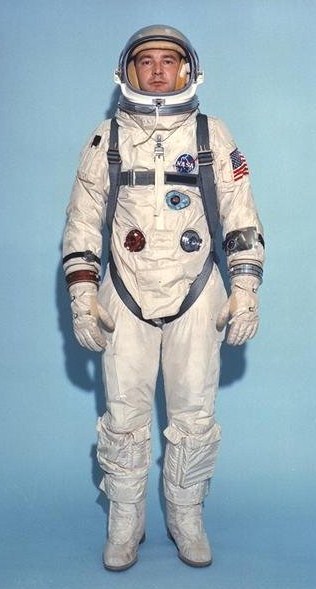
The Gemini spacesuit is a spacesuit worn by American astronauts for launch, in-flight activities and landing. It was designed by NASA based on the X-15 high-altitude pressure suit. All Gemini spacesuits were developed and manufactured by the David Clark Company in Worcester, Massachusetts.
Russell Sidney Colley was a U. S. mechanical engineer who played a role in creating the spacesuits worn by the Project Mercury astronauts, including fitting Alan B. Shepard Jr. for his historic ride as America's first man in space on May 5, 1961.

The Constellation Space Suit was a planned full pressure suit system that would have served as an intra-vehicular activity (IVA) and extra-vehicular activity (EVA) garment for the proposed Project Constellation flights. The design of the suit was announced by NASA on June 11, 2008, and it was to be manufactured by Houston, Texas-based Oceaneering International, the 4th company after the David Clark Company, Hamilton Sundstrand, and ILC Dover to produce life-support hardware, as a prime contractor, for in-flight space use.

The Launch Entry Suit (LES), known as the "pumpkin suit", is a partial-pressure suit that was worn by all Space Shuttle crews for the ascent and entry portions of flight from STS-26 (1988) to STS-65 (1994). It was completely phased out by STS-88 and replaced by the ACES suit. The suit was manufactured by the David Clark Company of Worcester, Massachusetts.

Neutral buoyancy simulation with astronauts immersed in a neutral buoyancy pool, in pressure suits, can help to prepare astronauts for the difficult task of working while outside a spacecraft in an apparently weightless environment.
